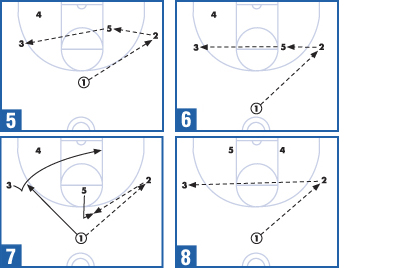Reversing the ball makes half-court offenses tough to defend
One of the most dramatic things a coach can do to improve his or her team’s half-court offense is to teach and reinforce effective reversal of the ball.
Failure to consistently reverse the ball results in “defensive loading.” Your offense becomes stagnant and stereotyped, and the defense profits from it.
An effective ball reversal involves:- Quick, sharp and well-executed passes.
- Reading the court and the reactions of the defense to the action. Each pass receiver must have vision and consciousness of the positioning and reactions that are presented.
Potential openings
Defensive players almost always focus on the ball during quick reversals, creating potential backdoor and flash cuts for your players.
DIAGRAM 1: Pass and screen to set up the ball reversal.
DIAGRAM 2: Flash cuts, backdoor cuts and quick ball reversal.
Keep the defense on its toes
Effectively reversing the ball forces defenders to alternate, playing ball-side and help-side defense. It challenges the defensive reads and reactions, and creates many opportunities for mistakes and breakdowns. It also greatly increases offensive productivity through more high-quality and varied scoring opportunities, more fouls by your opponents, and better opportunities for offensive boards.

Nearly all sound passes can be utilized in teaching ball reversal. We strongly favor solid two-hand chest and two-hand overhead passes. Other passes can come into play and be appropriate according to various situations.
There are four common methods of reversing the ball.
- Around the perimeter.
- Through the medium or low post.
- Through the high post.
- The skip pass.
DIAGRAM 3: Back around the perimeter (two passes). The two-pass reversal from wing-to-wing is quicker and more effective than the three-pass set.
DIAGRAM 4: Back around the perimeter (three passes). This is an example of reversing the ball around the perimeter by using a three-pass set.
DIAGRAM 5: Medium low-post reversal. Ball reversal through the medium or low post.

DIAGRAM 6: High-post reversal (elbow). Ball reversal through the high post at the elbow area.
DIAGRAM 7: High-post reversal (player 5 to the high point). It’s also effective to pull your post to the high point to reverse the ball quickly.
DIAGRAM 8: Skip pass (wing-to-wing). A skip pass is often more effective against the zone than a man defense. It shouldn’t be overused but can be extremely effective.
DIAGRAM 9: Skip pass (corner to point to wing).
Ball-reversal drill
Here are three primary drills that you can use to improve your team’s reversals. They are great “Monday” activities to establish effective ball movement as you begin each new week of practice. It’s also good to devote some appropriate time as needed to ball reversals the day before a game.

These drills promote the winning concept of “Move the people move the ball, and hit the open man.”
“13 Reverse” is a simple four-man drill that you can run with or without a defense. The action is basic entry give-and-go and reverse.
DIAGRAM 10: ’13 Reverse’ (initial pass movements). Run this drill so the cutter from the point receive the ball and score on a designated reverse: 1st, 2nd, 3rd, etc.
DIAGRAM 11: ’13 Reverse’ (ball reversal cut and score).









